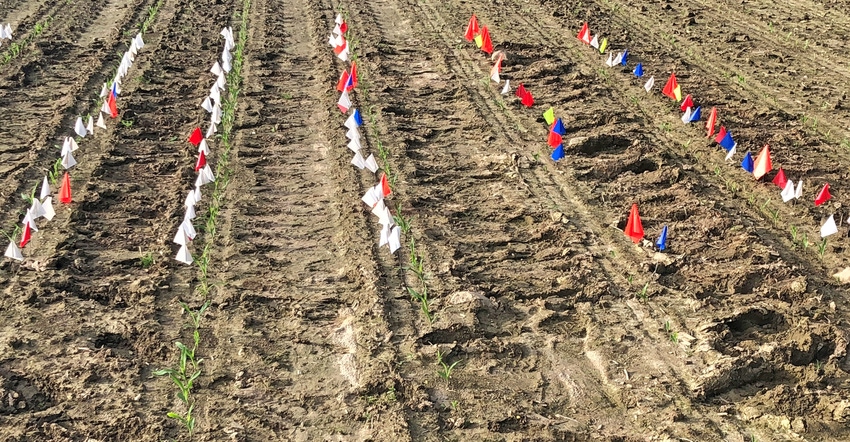
Speakers at planter clinics talk about even emergence. Most agronomists want all plants to emerge within 24 hours of each other, and certainly within 48 hours. Otherwise, late-emerging plants produce less.
“We’ve observed that in Corn Watch fields before,” Dave Nanda says. Nanda is director of genetics for Seed Genetics Direct, sponsor of Corn Watch ’20.
“We’ve noticed smaller plants next to larger plants early, and then saw what they produced later,” Nanda says. “If they produce an ear, it’s often much smaller.
“A corn plant which doesn’t produce an ear or only a small ear is worse than a weed. It robs productive plants of water, sunlight and nutrients. Yet you can’t take it out with herbicides.”
This is the first year that 1/1,000-acre areas were selected in the Corn Watch ’20 field as corn emerged. Flags of the same color were placed by all plants within a row emerging the same day. Twenty-four hours later, flags of a different color were placed by plants that emerged after the first day. The process was repeated each day. After 96 hours or longer since the first plants emerged, all plants had emerged.
Early observations
The Corn Watch ’20 field was planted May 13. The first plants emerged on May 23, 10 days after planting. The picture above was taken on May 27, four days after the first plants emerged. The light green flags are next to plants that emerged on the fourth day.
While this is still a work in progress, here’s what is obvious so far:
Quick emergence. The same procedure was followed as a trial run on a field planted on April 20. In that field, it was 14 days before the first corn emerged. While May temperatures were up and down, it was obviously warmer after May 13 than after April 20.
More even emergence overall. Not all rows of the study are shown in the picture. In all, 10 consecutive rows in one planter pass of a 24-row planter were included in the Corn Watch ’20 emergence test. In at least 80% of the rows, a very high percentage of plants emerged together on day 10 after planting. A super-high percentage emerged within 48 hours of each other. In the April planting, emergence was spread over more days.
Row-by-row differences. Emergence was much slower in the two rows on the far right, the eighth and ninth row from the outside edge of the field. There were also fewer plants emerged overall 14 days after planting compared to the other eight rows in the study.
What caused the difference? Right now, there are a couple of theories to explore. First, it’s possible this pair of rows lined up with planter tracks. It’s worth investigating. Second, heavy rains a couple of days after planting washed soil down the rows. There seemed to be more washing on these rows. Did seeds end up deeper in soil?
Look for more “digging” for answers. What’s clear is that rate of emergence was not the same on every row.
About the Author(s)
You May Also Like




